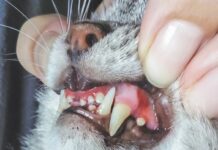Many cat owners know the frustration when a cat seems unable to urinate easily or suddenly stops using the litter box. One of the most common causes is disease of the lower urinary tract (the bladder and the urethra, the tube that carries urine from the bladder to the outside). Some causes of lower urinary tract disease – such as cystitis, its most common form – often go away on their own, while others, particularly an obstruction in the urethra, can be deadly serious. Yet the signs of these and the other lower urinary tract diseases are remarkably similar.
The cat will strain and perhaps expel only a few drops. Many people think such a cat is constipated, says Richard Goldstein, DVM, an internal medicine specialist at the Cornell University Hospital for Animals. He points out that many of the causes of feline lower urinary tract diseases remain unknown, so treatment depends on the type of disorder identified, the cats history, and some trial and error.
Diagnosis
To diagnose a lower urinary tract problem, the veterinarian will analyze urine (urinalysis) for acidity (pH), protein levels, the presence of crystals, the number of red and white blood cells, and bacteria. A blood test may be used to rule out systemic diseases, such as diabetes and hyperthyroidism. If necessary, an abdominal x-ray and/or ultrasound of the bladder may be performed to check for bladder stones, tumors, or anatomical defects.
Cystitis
Cystitis is one of the most common reasons why a cat goes to the veterinarian, yet we know very little about what causes it or what can effectively treat it, says Goldstein, who is board certified by the American College of Veterinary Internal Medicine. Because most cases resolve themselves in five to 10 days, virtually any appropriate medication used may appear to be effective. While costly (and invasive) procedures could definitively diagnose an inflammation of the bladder, veterinarians tend to tentatively diagnose idiopathic (of unknown cause) cystitis when bladder stones, bacterial infection, and systemic diseases are ruled out.
Goldstein allows a first episode of idiopathic cystitis to resolve itself, but he sometimes prescribes an antianxiety medication, particularly amytriptyline, if it recurs frequently. The fact that antianxiety medication often helps infers that stress may play a role in this condition, but this is very difficult to prove. Its likely due to inadequate drinking and urinating, he says. Yet, many veterinarians encourage cat lovers with felines prone to cystitis to minimize stress in the cats life.
Research is ongoing to determine whether the human disease – interstitial cystitis – is similar enough to the feline version that medications used for humans might benefit felines. In the meantime, although no medication has been proved effective, some veterinarians try corticosteroids in an attempt to reduce inflammation, and tranquilizers and antispasmodics (such as propantheline) to minimize muscle spasms of the bladder, and phenoxybenzamine for the urethra to relax the internal urethral sphincter to make urination easier if the sphincter is too tight or having spasms.
Crystals and plugs
Urethral plugs composed of varying quantities of protein and crystals are most often the cause of obstructions, although very small stones passing out of the bladder may occasionally lodge in the urethra, too. Urethral obstructions are life-threatening emergencies. With their narrow urethras, males are much more prone to obstructions, says Goldstein. Typical of a cat with lower urinary tract disease, a cat with an obstruction will strain while trying to eliminate, but the condition quickly worsens, causing great pain and possible coma and death in several days. Treatment involves relieving the obstruction by flushing the urethra with a catheter; sometimes the catheter may remain in place for up to several days. If obstructions develop more than three times, we consider a surgical procedure (perineal urethrostomy) to enlarge the urethral opening, Goldstein says. To ease inflammation and relax the urethral sphincter, a short course of corticosteroids and phenoxybenzamine, respectively, also may be prescribed to help make urination easier.
Because of the risk of an obstruction, a cat with any signs of a lower urinary tract disease should be immediately checked by a veterinarian, Goldstein concludes.
Bladder stones
While the incidence of one type of stone (magnesium ammonium phosphate, also known as struvite) has fallen dramatically in recent years because commercial foods now include ingredients (increased acid, lower magnesium) that help generate more acidic urine, the incidence of calcium oxalate stones has risen, perhaps due to the same changes in the food formulations.
While special diets may dissolve struvite stones, they cant dissolve other types.
The only way to determine the type of stone, however, is to remove it and have it analyzed. Then, if theres a recurrence, you can make a good guess whether a prescription diet (specially formulated for cats with urinary tract problems and available only through your veterinarian) would be effective. Several new prescription diets, however, may be able to prevent recurrence of both types of stones, says Goldstein. Canned food also can help prevent stones by boosting the water content of the diet, which promotes urination and lowers the concentration of the minerals in the urine, thereby lessening the chances of crystal formation. In cats that are vulnerable to forming stones, having crystals in urine (crystalluria) is a risk factor; but for cats not at risk, crystals in the urine may not be a problem.
One of the most effective ways to prevent problems is to encourage drinking by having fresh water always available. And since some cats like running water, perhaps one of those little fountains made for cat bowls could be installed.



